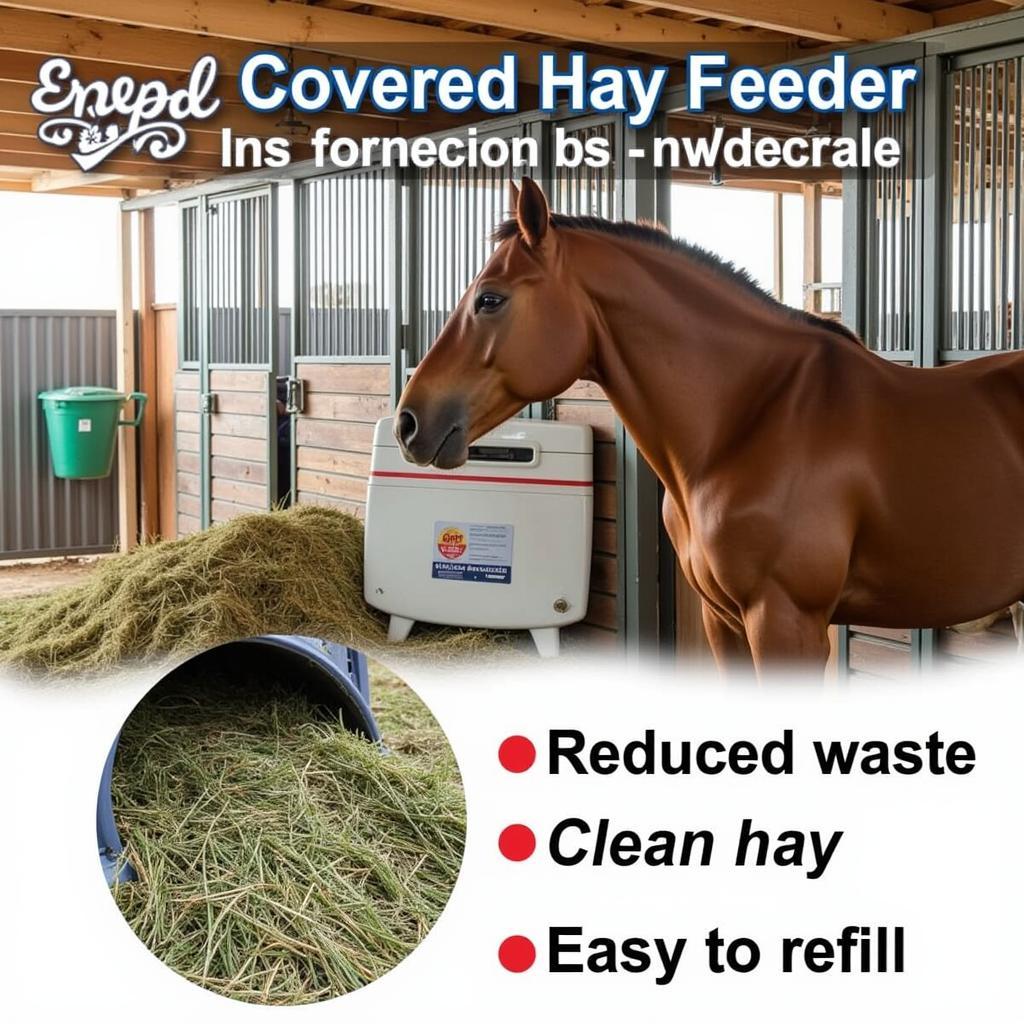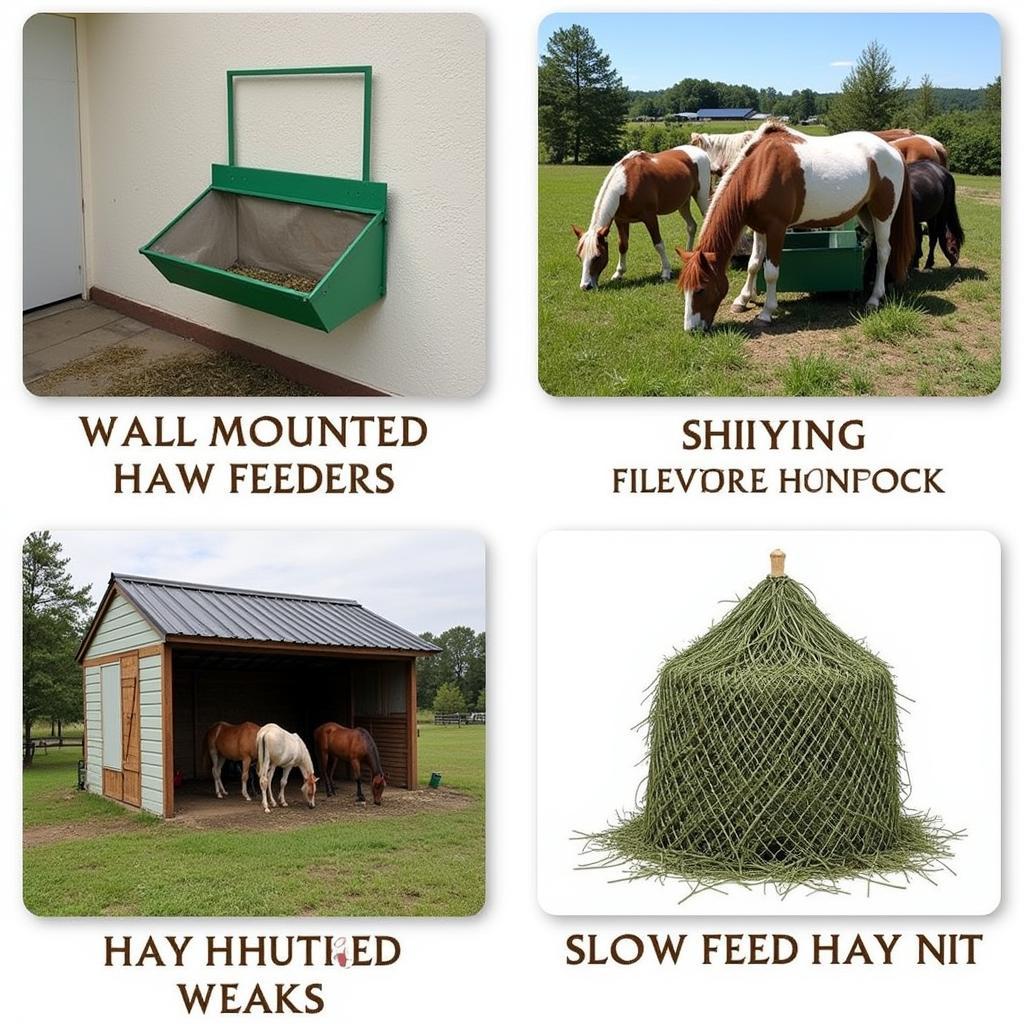Covered hay feeders are a staple for horse owners who understand the importance of providing their equine companions with clean, accessible, and waste-free forage. But with a plethora of options available, navigating the world of covered hay feeders can feel overwhelming. This comprehensive guide will delve into the benefits, types, and essential factors to consider when choosing the perfect covered hay feeder for your horses.
Why Choose a Covered Hay Feeder?
Horses are natural grazers, designed to consume forage throughout the day. Providing them with a constant supply of hay not only supports their digestive health but also helps alleviate boredom and prevent destructive behaviors. Covered hay feeders offer numerous advantages over traditional feeding methods:
- Reduced Waste: A significant portion of hay can be wasted when horses eat from the ground. Covered feeders minimize waste by preventing hay from being trampled, soiled, or blown away by the wind.
- Cleanliness and Hygiene: Protecting hay from the elements – rain, snow, dust – ensures it remains fresh, palatable, and free from mold or contamination. This is particularly crucial for horses with respiratory sensitivities.
- Controlled Intake: For horses prone to overeating or those on restricted diets, covered feeders with smaller openings can help slow down consumption and promote healthy eating habits.
- Convenience: Covered hay feeders often come in large capacities, reducing the frequency of refills. This is a major time-saver, especially for horse owners managing multiple animals.
 Benefits of Using a Covered Hay Feeder
Benefits of Using a Covered Hay Feeder
Types of Covered Hay Feeders
Choosing the right covered hay feeder depends on your horses, your budget, and your barn setup. Let’s explore the most common types:
1. Wall-Mounted Hay Feeders
- Ideal for: Smaller spaces, stalls, or paddocks where space is limited.
- Features: Attach securely to walls, minimizing wasted space.
- Considerations: Capacity might be limited compared to other types.
2. Free-Standing Hay Feeders
- Ideal for: Pastures, paddocks, or larger stalls with ample space.
- Features: Offer greater capacity, often with multiple feeding stations.
- Considerations: May require more space for maneuverability.
3. Hay Hutches
- Ideal for: Horses requiring extra protection from the elements.
- Features: Enclosed structures provide shelter from rain, snow, and wind.
- Considerations: Can be a more expensive option, requires a larger footprint.
4. Slow Feed Hay Nets
- Ideal for: Mimicking natural grazing patterns, promoting digestive health.
- Features: Small openings slow down consumption, reducing boredom.
- Considerations: Nets require regular cleaning and inspection for wear.
 Different Types of Covered Hay Feeders for Horses
Different Types of Covered Hay Feeders for Horses
Factors to Consider When Choosing a Covered Hay Feeder
Before you invest in a covered hay feeder, consider these essential factors:
- Herd Size: Determine the appropriate feeder capacity based on the number of horses you have.
- Feeding Habits: If your horses tend to overeat or have specific dietary needs, opt for feeders with slow-feed mechanisms or adjustable openings.
- Durability and Materials: Choose feeders constructed from sturdy, weather-resistant materials like galvanized steel or heavy-duty plastic.
- Ease of Cleaning: Select feeders with smooth surfaces and removable parts for effortless cleaning and hygiene maintenance.
- Safety: Inspect for sharp edges, protruding parts, or potential hazards that could injure your horses.
Covered Hay Feeders: A Wise Investment
Investing in covered hay feeders is a practical decision that yields significant benefits for both horses and owners. By prioritizing your horse’s health, well-being, and nutritional needs, you’re fostering a happier, healthier equine companion for years to come.
Frequently Asked Questions
1. How often should I clean my covered hay feeder?
Ideally, clean your feeder at least once a week. Remove any leftover hay, sweep out debris, and use a mild disinfectant if needed.
2. Can I use a covered hay feeder for other livestock?
Yes, covered hay feeders can be adapted for other livestock like goats, sheep, or alpacas.
3. What is the best material for a covered hay feeder?
Galvanized steel and heavy-duty plastic are popular choices due to their durability and resistance to rust and weathering.
4. How do I prevent my horse from wasting hay with a covered feeder?
Choose a feeder with a design that minimizes hay spillage and consider using slow-feed nets or grids within the feeder.
5. Are covered hay feeders suitable for horses with respiratory problems?
Yes, covered feeders are especially beneficial for horses with respiratory issues as they help keep the hay clean and dust-free.
For more information on caring for your horses, check out our article on horses turned out.
Looking for the perfect gift for the horse lover in your life? Explore our curated selection of horse rider Christmas gifts.
Need help choosing the right covered hay feeder for your horses? Contact us at Phone Number: 0772127271, Email: [email protected] or visit us at QGM2+WX2, Vị Trung, Vị Thuỷ, Hậu Giang, Việt Nam. Our dedicated customer support team is available 24/7 to assist you.